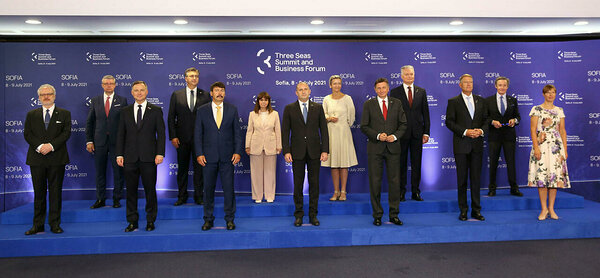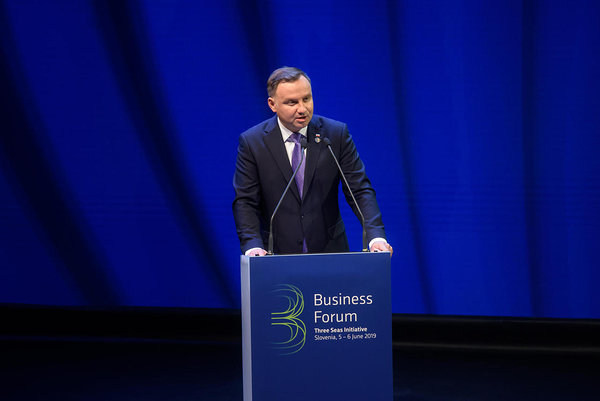Three Seas Story
Three Seas is an initiative that brings together 12 EU Member States between the Baltic, Black and Adriatic seas: Austria, Bulgaria, Croatia, the Czech Republic, Estonia, Hungary, Latvia, Lithuania, Poland, Romania, Slovakia and Slovenia.
History has dealt these Central and Eastern European nations very different hands, and their cultural and religious backgrounds are similarly diverse. Nevertheless, the stories of all 12 countries have one chapter in common: the Iron Curtain, which split Europe in two and stifled natural development, economic growth, and international unity in the region for half a century.
Whereas the nations of Western Europe are linked by roads and railways, power lines, and oil and gas pipelines, countries in Central and Eastern Europe remain comparatively disconnected from one another in terms of modern infrastructure. The deficit is particularly acute along the region’s north-south axis.
Three Seas Summit, Sofia 2021, Bulgarian News Agency (BTA)
Andrzej Duda. Photo: Nebojša Tejic, STA
To date, Three Seas Initiative summits have been held four times at the presidential level. What started out as a platform for the exchange of thoughts among the presidents of the countries involved, has expanded to include an annual business forum and the launch of an investment fund operating on a commercial basis. Politicians at executive levels of power in the 12 countries are also becoming increasingly involved in the initiative, and both Germany and the United States have become partners to it.
From the outset, the Three Seas was designed to complement rather than compete with the European Union. This is reflected in the close involvement of the European Commission in the initiative and its participation in all of the most recent summits.
Kolinda Grabar-Kitarović. Photo: Nebojša Tejic, STA
Whereas the nations of Western Europe are linked by roads and railways, power lines, and oil and gas pipelines, countries in Central and Eastern Europe remain comparatively disconnected from one another in terms of modern infrastructure. The deficit is particularly acute along the region’s north-south axis.
Three Seas Summit, Sofia 2021, Bulgarian News Agency (BTA)
Lack of investment
Although the common economic and customs space of the European Union has paved the way for the stable development of the continent as a whole, countries in Central and Eastern Europe continue to stand out from their counterparts in Western Europe for their economic disparity and outdated infrastructure. Despite the collective policies of the European Union, the gap that developed in the latter half of the 20th century has yet to be bridged. The shortfall in investments in the infrastructure, energy and digital fields is estimated to have grown over the years to as much as 1.15 trillion euros. Eliminating this deficit would give an enormous boost to development in the region and make Europe stronger and more united as a whole.Andrzej Duda. Photo: Nebojša Tejic, STA
The birth of the Three Seas initiative
Attention was drawn to Europe’s disparity in development in 2014 by a US think tank, the Atlantic Council, in a report entitled ‘Completing Europe’. This inspired the then heads of state of two countries – President Kolinda Grabar-Kitarović of Croatia and President Andrzej Duda of Poland – to launch an initiative, which has gone on to attract more and more senior figures and leading players from the worlds of business and politics. Each year, the Three Seas story gains a new chapter that looks to the future.To date, Three Seas Initiative summits have been held four times at the presidential level. What started out as a platform for the exchange of thoughts among the presidents of the countries involved, has expanded to include an annual business forum and the launch of an investment fund operating on a commercial basis. Politicians at executive levels of power in the 12 countries are also becoming increasingly involved in the initiative, and both Germany and the United States have become partners to it.
From the outset, the Three Seas was designed to complement rather than compete with the European Union. This is reflected in the close involvement of the European Commission in the initiative and its participation in all of the most recent summits.
Kolinda Grabar-Kitarović. Photo: Nebojša Tejic, STA
Untapped potential
By area, the Three Seas countries represent almost a third of the European Union and are home to 111 million people. However, figures from 2018 show that their average GDP per capita is just 78% of the EU average. At the same time, the average economic growth in the 12 countries from 2015-2019 was 3.5% compared to 2.1% in the European Union. The IMF forecast that the Three Seas countries would post an average economic growth of 2.9% in 2020, compared to an average of 1.6% for the European Union as a whole.Here we can only imagine the potential of a democratic Three Seas region that respects the principles of the rule of law and operates as a single market in a market economy. To unleash this potential, we must work together to eliminate the shortfall in investments.It is in order to realise this potential that the Three Seas Summit and international business forum are held at the presidential level each year, and it is also why the investment fund was launched in February 2020.
Find out more more about Three Seas objectives.


